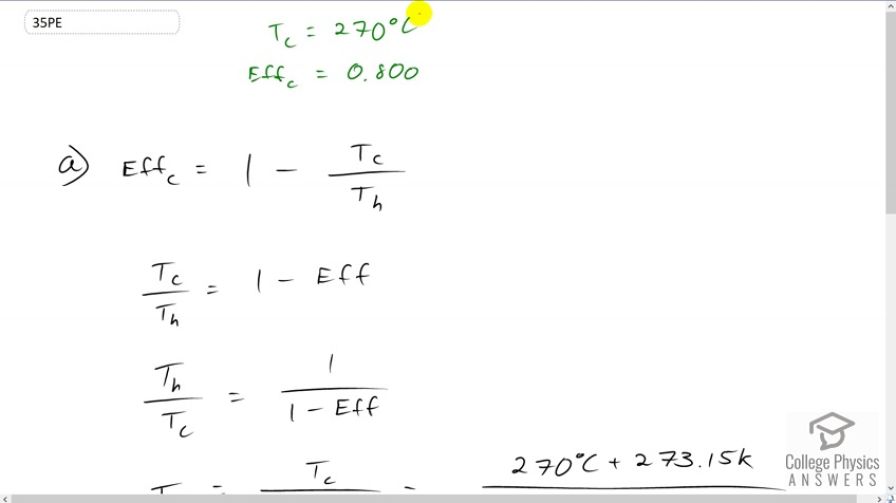Question
(a) Suppose you want to design a steam engine that has heat transfer to the environment at and has a Carnot efficiency of 0.800. What temperature of hot steam must you use? (b) What is unreasonable about the temperature? (c) Which premise is unreasonable?
Final Answer
- This temperature is higher than the melting point of iron () and of steel (typically )
- An efficiency of 0.80 is too high, as is the temperature of the environment (\textrm{C}$)
Solution video
OpenStax College Physics, Chapter 15, Problem 35 (Problems & Exercises)

vote with a rating of
votes with an average rating of
.
Calculator Screenshots
Video Transcript
This is College Physics Answers with Shaun Dychko. We have a hypothetical steam engine which is operating in an environment that has a temperature of 270 degrees Celsius, which already is an unrealistic number because there's no place on Earth that is that hot because that would have just be full of boiling water and steam. So, but anyway, that's the cold reservoir temperature. The Carnot efficiency of the steam engine is 0.80 and the question is what would the hot reservoir temperature be? In other words, what is the steam temperature going to be given these conditions? So, Carnot efficiency is 1 minus the cold reservoir temperature divided by the hot reservoir temperature and we're going to solve this for Th. So, we'll add Tc over Th to both sides and then we'll also subtract Carnot efficiency from both sides. And so, this makes zero on the left and this part makes zero on the right and we're left with 1 minus efficiency on the right and then Tc over Th on the left. And now we want to solve for Th, and so it's in the denominator, which is a bit of a tricky place for it to be. So let's put it in the numerator by taking the reciprocal of this fraction, and we do that by raising this fraction to the exponent negative 1. And what we do to the left side we also have to do to the right side so we also raise it to the exponent negative 1. So, this makes Th over Tc on the left and on the right hand side, we're flipping this fraction, and you can imagine this being over 1, and it becomes 1 over 1 minus Carnot efficiency. And then, we multiply both sides by Tc to get Th. So, the hot reservoir temperature is Tc over 1 minus Carnot efficiency. So, that's 270 degrees Celsius converted into Kelvin by adding 273.15 and we divide by 1 minus 0.80. And, that is 2715 Kelvin. And we'll convert that into degrees Celsius by subtracting 273, which gives 2440 degrees Celsius. So, this would be the temperature of the steam, in order to have, Carnot efficiency of 0.80 given in an environment of 270 degrees Celsius. Now this temperature is higher than the melting point of iron which is 1510 degrees Celsius and iron's a big part of steel, and steel has an even lower melting point. So, any steam engine has to be built out of some strong metal, and typically steel is the only economical strong metal and other exotic metals like titanium are more expensive and I haven't looked up their melting points, but it's likely less than this as well. So, the engine would melt given this steam temperature. And so, either the efficiency of 0.80 is too high or, as I've already mentioned, this environment is definitely too hot.
